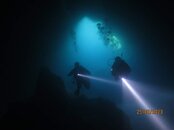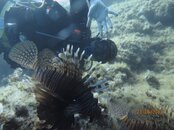OctopusLover
Registered
Hello all.
I recently took a long vacation to SE Asia, no intent to dive. After a few weeks of enduring extreme heat I had enough and decided to head to a mild island and try diving. I ended up in Koh Tao and after the open water, I immediately decided I wanted more. I felt somewhat hindered by other students who only wanted the license and didn't really actually care for learning anything, my instructor mentioned if I wanted to do continue training past OW I'd be alone with her so I went for it as a way to get private tutoring. Honestly this was a great idea, I got 100 times more actual learning time and felt like I really learnt to dive. With only 9 dives, 5 days back to back, and for 700$ total I ended up with OW + AOW + Nitrox. I was ready to do fun dives straight after but I'm asthmatic (have been cleared by thai and uk doctors separately since) and the combination of dry air from diving + dry air from strong A/C at night started to give me a bad cough a couple days after the last AOW dive and didn't want to risk it, so I stopped.
1 month later (last week) I was in Crete for a week and thought I'd try a fun dive. The first 2 fun dives were in a wall down to 36 meters. The instructor seemingly wanted to challenge me because he thought it was hilarious I got certified so quickly. I literally had to tell him to go up because my computer was showing 1 minute of NDL I moved to a different area of the island. 3rd and 4th the instructor was kind of baffled and started by having me demonstrating some basic skills to him (mask/regulator clearing), then showing me the local area. At the end he was commenting on how good my buyoancy/air consumption were (yay!) and invited me to join him and a dive master candidate on an "easy cave dive" the day after. At first I thought I understood that the "cave" would be short passages (I swear he said only a few meters) so I agreed. I only really agreed to this because the instructor was almost 60 years old and had been diving the area for 40 years. I felt very safe with him. Turns out the caves are actually 20/30 meters long but he said he's comfortable taking non-cave divers there because you can always see where the exit is. So yeah, my 5th and 6th fun dives ever were in complete darkness in caves.
I moved to a different area of the island. 3rd and 4th the instructor was kind of baffled and started by having me demonstrating some basic skills to him (mask/regulator clearing), then showing me the local area. At the end he was commenting on how good my buyoancy/air consumption were (yay!) and invited me to join him and a dive master candidate on an "easy cave dive" the day after. At first I thought I understood that the "cave" would be short passages (I swear he said only a few meters) so I agreed. I only really agreed to this because the instructor was almost 60 years old and had been diving the area for 40 years. I felt very safe with him. Turns out the caves are actually 20/30 meters long but he said he's comfortable taking non-cave divers there because you can always see where the exit is. So yeah, my 5th and 6th fun dives ever were in complete darkness in caves.
I'm not sure how uncommon this experience actually is and I'm not encouraging people to follow this path, but it is my experience and wanted to share
I recently took a long vacation to SE Asia, no intent to dive. After a few weeks of enduring extreme heat I had enough and decided to head to a mild island and try diving. I ended up in Koh Tao and after the open water, I immediately decided I wanted more. I felt somewhat hindered by other students who only wanted the license and didn't really actually care for learning anything, my instructor mentioned if I wanted to do continue training past OW I'd be alone with her so I went for it as a way to get private tutoring. Honestly this was a great idea, I got 100 times more actual learning time and felt like I really learnt to dive. With only 9 dives, 5 days back to back, and for 700$ total I ended up with OW + AOW + Nitrox. I was ready to do fun dives straight after but I'm asthmatic (have been cleared by thai and uk doctors separately since) and the combination of dry air from diving + dry air from strong A/C at night started to give me a bad cough a couple days after the last AOW dive and didn't want to risk it, so I stopped.
1 month later (last week) I was in Crete for a week and thought I'd try a fun dive. The first 2 fun dives were in a wall down to 36 meters. The instructor seemingly wanted to challenge me because he thought it was hilarious I got certified so quickly. I literally had to tell him to go up because my computer was showing 1 minute of NDL
I'm not sure how uncommon this experience actually is and I'm not encouraging people to follow this path, but it is my experience and wanted to share






